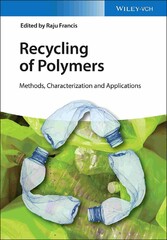
Recycling of Polymers - Methods, Characterization and Applications
von: Raju Francis
Wiley-VCH, 2016
ISBN: 9783527689033
Sprache: Englisch
288 Seiten, Download: 7478 KB
Format: PDF, auch als Online-Lesen
| Cover | 1 | ||
| Title Page | 5 | ||
| Copyright | 6 | ||
| Contents | 7 | ||
| Preface | 13 | ||
| List of Contributors | 17 | ||
| Abbreviations | 19 | ||
| Chapter 1 Introduction | 21 | ||
| 1.1 Introduction | 22 | ||
| 1.1.1 Why Recycling? | 22 | ||
| 1.1.2 Sources of Waste | 22 | ||
| 1.1.3 Plastics | 23 | ||
| 1.1.4 Recycling of Plastics | 23 | ||
| 1.1.5 Municipal Solid Waste | 24 | ||
| 1.1.6 Various Stages of Recycling Plastic Wastes | 26 | ||
| 1.1.7 Additives | 26 | ||
| 1.1.8 Mixed Plastics | 28 | ||
| 1.1.9 Composites | 28 | ||
| 1.2 Conclusion | 28 | ||
| References | 29 | ||
| Chapter 2 Common Additives used in Recycling of Polymers | 31 | ||
| 2.1 Review on Different Additives Used in Polymer Recycling | 31 | ||
| 2.1.1 Introduction | 31 | ||
| 2.1.1.1 Challenges in Recycling - Need for Additives | 31 | ||
| 2.1.1.2 Equipment for Additive Processing | 32 | ||
| 2.1.2 Different Types of Additives | 32 | ||
| 2.1.2.1 Stabilizing Agents | 34 | ||
| 2.1.2.2 Compatibilizers | 39 | ||
| 2.1.2.3 Antioxidants | 41 | ||
| 2.1.2.4 Impact Modifiers | 43 | ||
| 2.1.2.5 Fillers and Modifiers | 45 | ||
| 2.1.2.6 Antistatic Agents | 46 | ||
| 2.1.2.7 Coloring Agents | 46 | ||
| 2.1.2.8 Flame Retardants | 47 | ||
| 2.1.2.9 Lubricants | 48 | ||
| 2.1.2.10 Plasticizers | 48 | ||
| 2.1.2.11 Antibacterial or Antimicrobial Additives | 49 | ||
| 2.1.2.12 Coupling Agents | 49 | ||
| 2.1.3 Conclusion | 50 | ||
| References | 50 | ||
| 2.2 Recent Trends and Future of Polymer Additives in Macromolecular Recycling Technology: A Brief Overview | 51 | ||
| 2.2.1 Introduction | 51 | ||
| 2.2.2 Miscellaneous Additives | 52 | ||
| 2.2.2.1 Nucleating Agents | 52 | ||
| 2.2.2.2 Reinforcing Agents or Fillers | 53 | ||
| 2.2.2.3 Optical Brighteners | 56 | ||
| 2.2.2.4 Surface Improvers | 57 | ||
| 2.2.2.5 Antiblocking Additives | 59 | ||
| 2.2.2.6 Blowing Agents (Foaming Agents) | 59 | ||
| 2.2.2.7 Antifogging Agents | 61 | ||
| 2.2.3 New Trends in Additives Technology | 63 | ||
| 2.2.3.1 Advances in Stabilizers | 66 | ||
| 2.2.3.2 Advances in Flame Retardants (FRs) | 66 | ||
| 2.2.3.3 Advances in Plasticizers | 67 | ||
| 2.2.3.4 Advances in Coloring Agents | 67 | ||
| 2.2.3.5 Advances in Fillers | 68 | ||
| 2.2.3.6 Advances in Other Additive Classes | 68 | ||
| 2.2.3.7 Multifunctional Additives | 69 | ||
| 2.2.4 Conclusion | 69 | ||
| References | 70 | ||
| Chapter 3 Methods of Recycling | 75 | ||
| 3.1 Methods of Recycling of Polymers: Addition Polymers | 75 | ||
| 3.1.1 Introduction | 75 | ||
| 3.1.2 Primary Recycling | 78 | ||
| 3.1.3 Mechanical Recycling (or Secondary Recycling) | 78 | ||
| 3.1.4 Chemical or Feedstock Recycling (Tertiary Recycling) | 79 | ||
| 3.1.5 Energy Recovery (Quaternary Recycling) | 80 | ||
| 3.1.6 Chemical Recycling of Polyethylene (LDPE and HDPE) | 82 | ||
| 3.1.6.1 Introduction | 82 | ||
| 3.1.6.2 Thermolysis Schemes and Technologies | 83 | ||
| 3.1.6.3 Reactor Types | 85 | ||
| 3.1.7 Polyolefin Thermal Cracking | 86 | ||
| 3.1.7.1 Catalytic Degradation | 86 | ||
| 3.1.8 Chemical Recycling of Polypropylene | 87 | ||
| 3.1.8.1 Introduction | 87 | ||
| 3.1.8.2 Pyrolysis | 89 | ||
| 3.1.8.3 Co-pyrolysis | 90 | ||
| 3.1.8.4 Catalytic Cracking | 91 | ||
| 3.1.9 Chemical Recycling of Polystyrene | 95 | ||
| 3.1.9.1 Introduction | 95 | ||
| 3.1.9.2 Recycling Methods for Polystyrene Products | 96 | ||
| 3.1.9.3 Future Prospects | 103 | ||
| 3.1.10 Chemical Recycling of Poly(vinyl chloride) | 103 | ||
| 3.1.10.1 Introduction | 103 | ||
| 3.1.10.2 Mixed Plastic Recycling Processes | 106 | ||
| 3.1.10.3 Mixed PVC Wastes World Initiatives | 108 | ||
| 3.1.10.4 The BASF Feedstock Recycling Process | 108 | ||
| 3.1.10.5 Veba Combi Cracking Process | 110 | ||
| 3.1.11 Chemical Recycling of Poly(methyl methacrylate) | 110 | ||
| 3.1.11.1 Introduction | 110 | ||
| 3.1.11.2 Dissolution/Reprecipitation | 111 | ||
| 3.1.11.3 Chemical/Feedstock Recycling | 112 | ||
| References | 113 | ||
| 3.2 Methods of Recycling of Polymers: Condensation Polymers | 121 | ||
| 3.2.1 Introduction | 121 | ||
| 3.2.2 Chemical Recycling of Nylon | 121 | ||
| 3.2.2.1 Introduction | 121 | ||
| 3.2.2.2 Recycling Methods | 121 | ||
| 3.2.3 Chemical Recycling Involving Depolymerization of Nylons Which Can Be Carried Out by Hydrolysis or Ammonolysis of Nylon 6,6 and Nylon 6 | 122 | ||
| 3.2.3.1 Hydrolysis of Nylon 6 | 122 | ||
| 3.2.3.2 Hydrolysis of Nylon 6,6 and Nylon 4,6 | 123 | ||
| 3.2.3.3 Ammonolysis of Nylon 6,6 | 123 | ||
| 3.2.3.4 Recovery of Nylon 6,6 Monomers | 124 | ||
| 3.2.3.5 Catalytic Pyrolysis | 125 | ||
| 3.2.3.6 Applications of Depolymerized Nylon 6 | 125 | ||
| 3.2.4 Chemical Recycling of Polycarbonate | 125 | ||
| 3.2.4.1 Introduction | 125 | ||
| 3.2.4.2 Recycling Techniques | 126 | ||
| 3.2.5 Advantages of Recycling and Reuse of Polymers | 130 | ||
| References | 132 | ||
| Chapter 4 Recycling of Plastics | 135 | ||
| 4.1 Introduction | 135 | ||
| 4.2 Plastic Waste Management Scenario | 137 | ||
| 4.3 Ways of Recycling | 139 | ||
| 4.3.1 Reuse | 140 | ||
| 4.3.2 Mechanical Recycling | 141 | ||
| 4.3.3 Chemical Recycling | 141 | ||
| 4.4 Poly(Lactic Acid) | 142 | ||
| 4.5 Poly(Vinyl Chloride) | 145 | ||
| 4.6 Polyethylene | 146 | ||
| 4.7 Polypropylene | 148 | ||
| 4.8 Polystyrene | 149 | ||
| 4.9 Poly(Ethylene Terephthalate) (PET) | 149 | ||
| 4.10 Applications | 154 | ||
| References | 155 | ||
| Chapter 5 Recycling of Rubber | 161 | ||
| 5.1 Introduction | 161 | ||
| 5.2 Rubber | 162 | ||
| 5.3 Recycling of Rubber Products | 163 | ||
| 5.3.1 Chemical Process | 163 | ||
| 5.3.2 Physical Methods | 165 | ||
| 5.3.2.1 Mechanochemical Techniques | 165 | ||
| 5.3.2.2 Microwave Technique | 166 | ||
| 5.3.2.3 Ultrasonic Technique | 166 | ||
| 5.3.2.4 Twin-Screw Extruder | 168 | ||
| 5.3.3 Biological Process | 168 | ||
| 5.4 Applications of Recycled Rubber | 172 | ||
| 5.4.1 Sound-Insulation Materials | 172 | ||
| 5.4.2 Civil Engineering Applications | 173 | ||
| 5.4.3 Oil Absorbent | 174 | ||
| 5.4.4 Energy Production | 174 | ||
| 5.4.5 Zinc Fertilizer | 175 | ||
| 5.5 Concluding Remarks | 175 | ||
| References | 176 | ||
| Chapter 6 Fibers | 183 | ||
| 6.1 Introduction | 183 | ||
| 6.2 Natural Fibers | 184 | ||
| 6.2.1 Kenaf | 185 | ||
| 6.2.2 Cotton | 187 | ||
| 6.2.3 Sisal | 190 | ||
| 6.2.4 Asbestos | 194 | ||
| 6.3 Synthetic Fibers | 196 | ||
| 6.3.1 Nylon | 197 | ||
| 6.3.2 Polyester | 202 | ||
| 6.3.3 Glass Fiber | 207 | ||
| 6.3.3.1 Glass Fiber-Reinforced Plastics | 208 | ||
| 6.3.3.2 Mechanical Process | 208 | ||
| 6.3.3.3 Thermal Process | 208 | ||
| 6.3.3.4 Chemical Recycling | 210 | ||
| 6.3.4 Carbon Fiber | 212 | ||
| 6.3.4.1 Mechanical Recycling | 212 | ||
| 6.3.4.2 Thermal Recycling | 213 | ||
| 6.3.4.3 Chemical Recycling | 215 | ||
| 6.4 Conclusion | 218 | ||
| References | 218 | ||
| Chapter 7 Recycling of Polymer Blends and Composites (Epoxy Blends) | 229 | ||
| 7.1 Introduction | 229 | ||
| 7.2 Polymer Blends and Composites | 229 | ||
| 7.2.1 Methods of Recycling | 233 | ||
| 7.2.1.1 Mechanical Recycling | 233 | ||
| 7.2.1.2 Chemical Recycling | 235 | ||
| 7.2.1.3 Thermal Recycling | 236 | ||
| 7.3 Characterization and Application of Recyclates | 238 | ||
| 7.4 Conclusions | 239 | ||
| References | 239 | ||
| Chapter 8 Recycling of Other Layered Mixed Plastics or Resins: Polyurethanes | 243 | ||
| 8.1 Introduction | 243 | ||
| 8.2 Mechanical Recycling | 246 | ||
| 8.3 Chemical Recycling | 247 | ||
| 8.3.1 Glycolysis | 248 | ||
| 8.3.2 Hydrolysis | 249 | ||
| 8.3.3 Aminolysis | 249 | ||
| 8.4 Thermochemical methods | 250 | ||
| 8.4.1 Pyrolysis | 250 | ||
| 8.4.2 Gasification | 250 | ||
| 8.4.3 Hydrogenation | 250 | ||
| 8.5 Energy Recovery by Incineration | 251 | ||
| References | 252 | ||
| Chapter 9 Ecoprofiles of Recycled Polymers at a Glance | 255 | ||
| 9.1 Advantages of Recycled Polymers on the Environment | 255 | ||
| 9.1.1 Introduction | 255 | ||
| 9.1.2 Poly(ethylene terephthalate) (PET) | 256 | ||
| 9.1.3 High-Density Polyethylene (HDPE) | 257 | ||
| 9.1.4 Poly(vinyl chloride) (PVC) | 259 | ||
| 9.1.5 Polypropylene (PP) | 260 | ||
| 9.1.6 Polystyrene (PS) | 261 | ||
| 9.1.7 Other Polymers | 262 | ||
| 9.1.8 Conclusion | 265 | ||
| References | 265 | ||
| 9.2 Toxic or Environmental Effects of Recycled Polymers | 268 | ||
| 9.2.1 Introduction | 268 | ||
| 9.2.2 Will Recycling Reduce the Amount of Waste? | 269 | ||
| 9.2.2.1 Recycling of Waste Electrical and Electronic Equipment (WEEE) | 270 | ||
| 9.2.2.2 Recycling of Tires | 271 | ||
| 9.2.2.3 Recycling of Plastics | 271 | ||
| 9.2.2.4 Recycling of Polymers | 271 | ||
| 9.2.2.5 Health Problems | 272 | ||
| 9.2.2.6 Recycling by Polymer Incineration | 272 | ||
| 9.2.3 Conclusion | 273 | ||
| References | 273 | ||
| Index | 277 | ||
| EULA | 285 |








